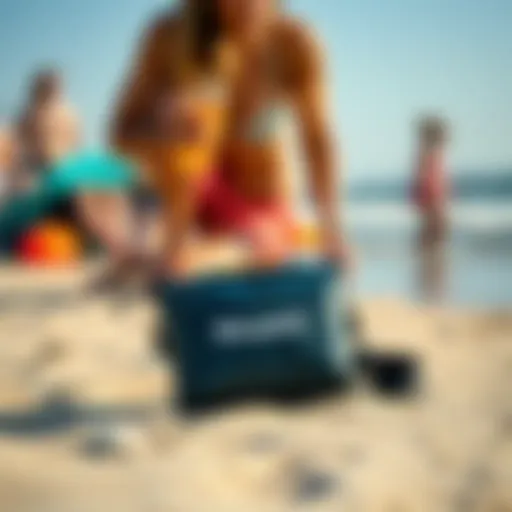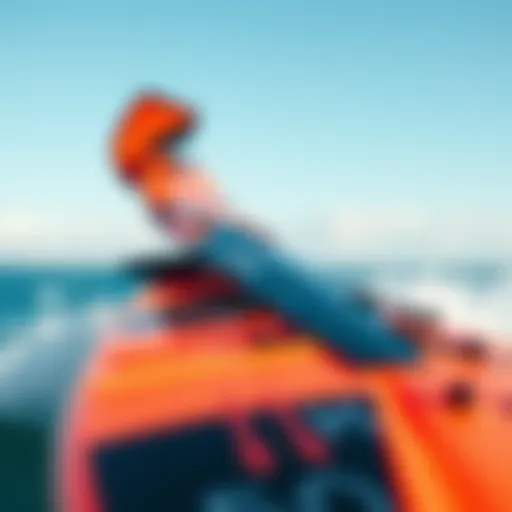Essential Weather Radar Insights for Gulf Breeze Kiteboarding
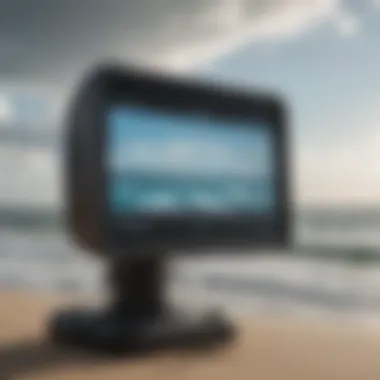

Intro
In the vibrant coastal town of Gulf Breeze, Florida, the winds whip up adrenaline-packed moments for kiteboarders yearning to ride the waves. With the nearby Gulf of Mexico offering ideal conditions, understanding the intricacies of weather radar becomes essential for both safety and an exhilarating experience on the water. It’s not just about catching the perfect breeze; it’s also about interpreting the signals that the skies send our way.
Weather radar technology serves as a pivotal tool in forecasting conditions that could either make or break a kiteboarding session. By leveraging these insights, enthusiasts can dodge potential hazards and capitalize on optimal weather patterns. Whether you’re a seasoned expert or just starting off, grasping how weather radar plays into kiteboarding activities is paramount.
Let’s dive into the specifics, starting with gear insights that help enhance your kiteboarding adventure while keeping safety at the helm.
Understanding Weather Radar
Weather radar is an invaluable tool, especially for those who enjoy kiteboarding in Gulf Breeze, Florida. Understanding how it works can enhance safety and enrich the experience for enthusiasts. It empowers kiteboarders with real-time data, arming them against unforeseen weather changes that could turn a beautiful day on the water into a treacherous endeavor.
Definition and Purpose
At its core, weather radar is a system that uses radio waves to detect and locate precipitation, gauge storm intensity, and estimate wind speed and direction. The primary purpose of weather radar is to provide timely and accurate information about impending weather conditions, allowing kiteboarders and other outdoor enthusiasts to make informed decisions about when and where to go. The effectiveness of this tool cannot be understated; it brings clarity to the often chaotic and unpredictable nature of Florida's weather.
How Weather Radar Works
Basic Principles
The basic principle behind weather radar involves sending out radar beams, which bounce off particles in the atmosphere. This interaction allows the radar to measure both the distance to the rain or storm and its intensity. One key characteristic of these systems is their ability to deliver real-time updates. This immediacy can be a game changer for kiteboarders; knowing the weather conditions moments after they change can mean the difference between a safe outing and a hazardous one. A unique feature of these radar systems is their Doppler effect, which can detect movement and speed of storm systems, crucial information for anyone on the water.
Types of Weather Radars
There are several types of weather radars, each tailored to specific meteorological needs. The most common include Doppler radar and phased array radar. Doppler radar stands out for its ability to measure the velocity of storms and precipitation. Its popularity stems from its precision in identifying winds, which is particularly important for kiteboarders who need to know about wind patterns. On the flip side, phased array radar is a newer technology that allows for rapid scanning of the atmosphere, providing more frequent updates. Both types have their advantages; while Doppler radar excels in detail, phased array offers speed, giving users a fuller picture of the weather landscape.
Importance in Meteorology
Weather radar plays an essential role in meteorology, enabling scientists and meteorologists to analyze storm systems and predict their paths. It assists in issuing timely warnings that can save lives and property. For kiteboarders, it not only offers a glimpse into the immediate weather but also helps in understanding seasonal patterns—knowledge that is vital for planning safe trips. The implications go beyond mere enjoyment; they involve safety protocols and preparedness that are crucial for those who ride the winds over the waters of Gulf Breeze.
"Understanding weather radar is not just for meteorologists – it’s a lifeline for enthusiasts on the water."
In essence, gaining insights on weather radar opens doors to not just improved safety but a richer kiteboarding experience, giving hobbyists the confidence they need to navigate Florida's diverse climatic conditions.
Local Weather Patterns in Gulf Breeze
Understanding the local weather patterns in Gulf Breeze holds immense significance, especially for those who sail on the winds, like kiteboarders. Weather influences decision-making for all outdoor activities, so knowing the local climate can turn a decent day into a spectacular one—or vice versa. Gulf Breeze, with its unique geographical and seasonal characteristics, serves as a case study in how localized weather patterns can profoundly impact not just daily life but specific recreational activities such as kiteboarding.
Geographical Influences
Gulf Breeze is nestled along the northern stretch of the Gulf of Mexico, a prime spot where the breezy coastal winds meet the warm sun. The region’s topography plays a pivotal role in shaping its weather. The presence of water bodies, such as Pensacola Bay, often moderates temperatures, leading to milder winters compared to inland areas. This geographical setting also facilitates the formation of sea breezes, especially during the summer months, which can significantly enhance kiteboarding conditions.
The expanse of coastal land and maritime influence brings a steady rhythm to the local climate. For anyone keen on kiteboarding, understanding geographical influences means recognizing the good spots to launch and the best times to enjoy the winds.
Seasonal Weather Trends
Summer Storms
In Gulf Breeze, summer storms aren’t unusual but rather a hallmark of the warm months. These storms can pop up seemingly out of nowhere, often characterized by brief but intense bursts of wind and rain. Kiteboarders should know that these storms can bring sudden changes in wind patterns, making it crucial to monitor weather radar closely.
The allure of these summer storms lies in their vitality. The winds preceding a storm can provide thrilling conditions for experienced kiteboarders. However, they arrive with risks. It’s a double-edged sword: wind can mean excitement, but it also calls for caution. One minute you might be riding high on a wave, and the next you could be battling strong gusts or even lightning. Knowledge about the timing and characteristics of these storms is indispensable for making informed decisions.
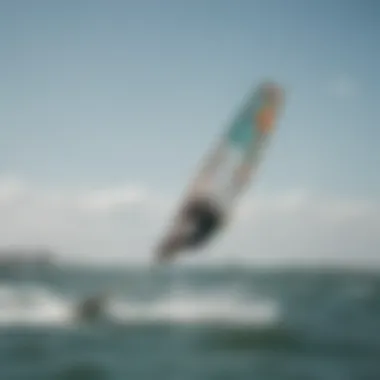

Winter Variability
Winter in Gulf Breeze presents a contrast to the summer's flair. Though it may not bring severe cold, the seasonal variability does lead to unpredictable weather patterns. This can manifest in much less consistent wind conditions, which is something kiteboarders must navigate. The local adage goes, "Don’t assume it’s easy just because it’s winter." This tells us that the challenges presented during chilly months can be just as daunting.
What makes winter variability noteworthy is the unpredictability factor—some days deliver gentle breezes, while others are dead calm. As kiteboarders know, achieving the right conditions can often mean the difference between a great session and an aborted plan. Understanding this seasonal rhythm is crucial for those who are looking to sharpen their skills year-round.
Heat and Humidity Effects
Local Climate Statistics
Delving into local climate statistics provides kiteboarders with valuable insights into Gulf Breeze weather. The climate is classified as humid subtropical, marked by hot summers and mild winters. Average summer temperatures can soar above 90°F, accompanied by equally high humidity levels, which may easily reach 80%.
The significant humidity can sometimes lead to discomfort, especially when exerting yourself outdoors. For kiteboarders, understanding how heat and humidity interact is essential. Thus, hydration and planning for the cooler parts of the day can make an enormous difference to one's kiteboarding experience. Typically, mornings tend to offer stronger winds, ideal for catching the waves before the heat kicks in.
Impact on Kiteboarding
The high levels of heat and humidity directly influence kiteboarding activities, essentially dictating when and how long kiteboarding sessions can last. The statistic, "More in, less out," can apply here. Simply put, humid mornings are often the sweet spot for kiteboarders, while the blistering afternoons may push riders to seek shelter.
Furthermore, heat and humidity can also affect equipment. Kiteboards may require adjustments or different gear during the humid summer months; knowing how your gear behaves can help avoid mishaps.
While the summer heat can be oppressive, the early hours often bring the best winds, a fact that kiteboarders should always keep in mind. Staying attuned to these local weather patterns will enhance both the safety and enjoyment of kiteboarding in Gulf Breeze.
Weather Radar's Role in Kiteboarding
Weather radar serves as an essential compass guiding kiteboarders through the often unpredictable and dynamic weather patterns that characterize Gulf Breeze, Florida. This technology not only provides a foundational understanding of approaching weather phenomena but it can also arm enthusiasts with the insights they need to make informed decisions on the water. With kiteboarding relying heavily on favorable wind and weather conditions, ignoring these factors can lead to dangerous situations that threaten safety.
Anticipating Weather Changes
Kiteboarders know that the winds can shift in the blink of an eye. The role of weather radar in this context can't be overstated. Radar systems detect changes in weather patterns that may foreshadow shifts in wind direction and velocity. For example, a sudden drop in pressure could indicate an upcoming storm or a quick shift in wind that might affect the kiteboarding experience. By monitoring these radar indicators, kiteboarders can prepare to adjust their plans or equipment accordingly, ultimately leading to a safer and more enjoyable outing.
Monitoring Storm Development
Staying a step ahead of storm development is paramount for anyone venturing out on the water. Weather radar can track storm growth as well as its intensity, giving kiteboarders critical information on what to expect. A radar echo can promptly signal the approach of a storm, which allows kiteboarders to ditch their boards before the winds turn hostile and conditions become treacherous. Knowledge of storm pathways also helps them identify safe zones and escape routes, ensuring a safer experience on the water.
Advisories and Alerts
Utilizing Radar Data
Utilizing radar data is akin to having a weather-savvy teammate on your side while kiteboarding. The specific aspect of this data is its detailed read on precipitation, wind speeds, and storm systems affecting the Gulf Breeze area. What stands out about this information is how timely it is. For instance, real-time data can result in immediate adjustments to planned kiteboarding sessions.
Unique features of radar data lie in its precision and accuracy. Kiteboarders can check if a quick squall is coming their way or if a sunny patch will last longer than initially thought. The trade-off is the necessity for kiteboarders to actively monitor the information; relying solely on outdated forecasts or social media chatter isn't a substitute for this direct radar insight.
Understanding Weather Alerts
Understanding weather alerts is just as crucial as interpreting radar data itself. Weather alerts provide timely notifications about hazardous conditions, including strong winds or severe storms. The core characteristic of these alerts is their ability to convey urgent information quickly. For kiteboarders, being able to interpret alerts helps them make informed decisions—like whether to head out or stay on the shore.
One unique feature of weather alerts is their integration with technology; many kiteboarding apps and local weather stations use these alerts to send notifications directly to users’ devices. While this is incredibly convenient, it does have its downsides—dependent on cellular coverage or battery life could lead to complications at critical moments. Therefore, it’s wise for kiteboarders to maintain a solid understanding of weather alert systems along with how to assess their implications.
Interpreting Radar Data for Kiteboarding
Understanding radar data is essential for kiteboarders, especially in a dynamic weather environment like Gulf Breeze, Florida. This knowledge empowers enthusiasts to make informed decisions, prioritizing safety without sacrificing the thrill of the wind and waves. An accurate interpretation of radar data allows kiteboarders to gauge the conditions ahead, ensuring that their kiteboarding adventures are both enjoyable and secure.
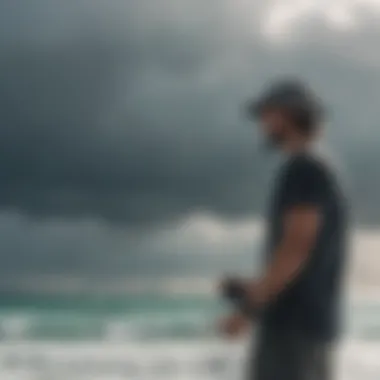

Reading Weather Radar Images
Weather radar images might seem like a puzzle at first glance, but once you know what to look for, they provide a wealth of information. These images show various colored echoes that indicate where precipitation is occurring.
- Colors Matter: The colors generally range from green, meaning light rain, to reds and purples, indicating heavier rainfall. Knowing these color codes becomes super helpful when you're out on the water.
- Zoning In: Focus on the areas with darker reds or purples when planning your kiteboarding session.
- Trends Over Time: Look for changes in the radar images over time to predict where storms may move. Patterns can appear that helps you understand if conditions will deteriorate or improve.
Using weather radar images properly can prevent kiteboarders from being caught off guard by sudden storms or high winds.
Identifying Rain and Wind Patterns
A kiteboarder's experience is largely determined by the relationship between rain and wind patterns. Before heading out, it's vital to understand these elements and how they fluctuate.
- Rain Indicators: Rain is not just a hassle; it often comes with strong winds. Look for storm cells on radar. These cells often signal changes in wind patterns. If rain is predicted in a region, better to reconsider your plans.
- Wind Direction and Speed: Radar also provides clues about wind behavior. Regions with rising or falling precipitation can indicate shifts in wind direction and strength. This insight allows for safer choices, maximizing your kiteboarding experience.
- Flow with the Flares: Just because the sun is shining doesn’t mean it’s kiteboarding time. Seeing wind shifts on the radar can offer a heads-up for potential trouble spots or areas where kiteboarding is prime and ready!
Understanding Doppler Radar Information
Doppler radar is a powerful tool that offers an insightful peek into the atmosphere. It helps to assess not only the location of precipitation but also the wind's movement and its intensity.
- Velocity Matters: By gauging the wind speeds and direction, Doppler radar can provide critical information, such as potential gusts that may catch an unprepared kiteboarder off guard.
- Interactive Insights: Some radar systems have interactive capabilities, allowing users to monitor live updates on wind and precipitation. These updates are especially crucial for kiteboarders wanting to fine-tune their timing and venues.
- Storm Predictions: Doppler can forecast where storms may wind up moving. Pay attention to this information; it can create a safer environment when you're out on the water.
"Staying ahead of the weather is not just smart—it's the difference between a fun day on the water and an unexpected race against raw nature."
By mastering the interpretation of radar data, kiteboarders in Gulf Breeze can transform a potentially hazardous situation into a controlled and enjoyable experience. Engaging with radar not only keeps enthusiasts safe but also enhances their overall kiteboarding adventures.
Real-Time Applications of Weather Radar
Weather radar plays a crucial role in ensuring safety and optimizing the experience for kiteboarders in Gulf Breeze. Understanding how to utilize real-time data can make a marked difference in navigating weather unpredictability. Let's break down a few key components that demonstrate the significance of real-time applications.
Mobile Apps and Online Tools
In the digital age, kiteboarders have a wealth of information at their fingertips. Specialized mobile applications like Windy or MyRadar offer real-time updates on wind speed, direction, and storm activity. These apps utilize data from various weather radars to present a comprehensive view of the current environmental conditions. The importance of such tools cannot be overstated.
Key Benefits:
- Instant Updates: Kiteboarders can receive alerts on changing weather conditions, such as sudden wind gusts or incoming showers, allowing for timely decisions to head back or extend their session.
- User-Friendly Interface: Most apps are designed for ease of use, ensuring that even those less tech-savvy can navigate through the information without a hitch.
- Customization Options: Many of these applications allow users to set geographical preferences, ensuring the data is relevant to Gulf Breeze specifically.
Using Social Media for Updates
Social media has evolved into a valuable tool for communication and information sharing. Local kiteboarding groups on platforms like Facebook or Reddit serve as hubs for real-time announcements regarding weather updates and safety advisories.
Engaging with these communities provides kiteboarders with the chance to gather localized knowledge. Perhaps a fellow enthusiast shares a recent experience about afternoon storms or currents. This kind of information is often just as valuable as any radar data.
Considerations:
- Real-Time Discussion: Engaging in conversations can lead kiteboarders to gain insights not captured by radars, such as how the water feels or which spots are currently busy.
- Official Alerts: Many local meteorological offices and organizations post live alerts about hazardous conditions on their social media pages. Following those accounts can keep kiteboarders informed about potential risks.
Connecting with Local Weather Stations
Relying solely on mobile apps and social media can miss out on the wealth of knowledge provided by local weather stations. These stations often give detailed weather reports tailored to specific locales, including Gulf Breeze. Establishing a connection with nearby stations can yield more precise data regarding water and wind conditions.
Advantages:


- Accurate Forecasting: Local stations monitor their region closely, often yielding more accuracy than generalized forecasts available online.
- Collaborative Reporting: Kiteboarders can provide feedback or updates on conditions directly to these stations, fostering a two-way street of information exchange.
With modern technology and community networks, kiteboarders can navigate the challenges of weather more intelligently. The risks of ignoring weather radar can be high, but with real-time applications, enthusiasts can make informed decisions, thereby enhancing both enjoyment and safety on the water.
Safety Considerations for Kiteboarders
When out on the waters of Gulf Breeze, kiteboarders are often caught in the sweet thrill of gliding across the surface. Yet, this exhilaration comes with risks that can escalate quickly if they aren't duly considered. Weather, especially, plays a pivotal role in kiteboarding safety, making it crucial to emphasize Safety Considerations for Kiteboarders. This section delves deeper into the implications of ignoring weather radar, how to prepare for changing conditions, and essential emergency procedures that should be top of mind for anyone looking to catch some wind.
The Risks of Ignoring Weather Radar
Ignoring weather radar can put kiteboarders in peril—period. When riders turn a blind eye to the information offered by radar, they increase the likelihood of encountering sudden weather changes. One minute, the sky might be clear, but moments later, a storm can sweep in, bringing not just high winds, but also heavy rain and lightning.
- Data Insights: Utilizing weather radar provides insights into wind speed, precipitation, and developing storms. Kiteboarders who disregard this data may find themselves facing conditions that can turn a fun day on the water into a precarious struggle for safety.
- Real-Life Instances: There have been instances where enthusiasts failed to check radar updates. Some ended up capsizing due to unexpected spikes in wind speed, showcasing the undeniable necessity for radar awareness.
Preparing for Changing Conditions
Preparation is half the battle in kiteboarding. Knowing how to physically prepare and mentally anticipate sudden shifts in weather can make a considerable difference between a delightful outing and a disastrous experience.
- Pre-Flight Briefings: Before taking to the sea, checking the weather forecast and understanding radar patterns becomes essential. Kiteboarders should not just rely on outdated apps but stay in touch with local meteorological updates—especially ones tailored for their region.
- Flexible Plans: Keeping plans fluid can save lifetimes. Reserving flexibility to alter one's route or timing based on emerging data from weather radar can help kiteboarders evade nasty squalls.
Emergency Procedures
In the unfortunate event that a kiteboarder finds themselves caught in a sudden storm or other perilous situations, knowing emergency procedures can be a life-saver. This includes both immediate responses and gear preparedness.
Responding to Storms
Prompt and appropriate responses to storms can considerably impact the safety of a kiteboarder at sea. If forecasters or radar indicate developing storms, the first step should be returning to shore immediately.
- Key Characteristics: The ability to assess storms in real time is paramount. Kiteboarders should familiarize themselves with radar data nuances to make informed decisions swiftly.
- Unique Features: Radar often displays storm cell movements. Observing these movements allows riders to plan escapes. However, it’s crucial to do so with urgency because these storms can build fast and unexpectedly.
Safety Gear Recommendations
Venturing out into unpredictable weather requires that kiteboarders are equipped with the proper safety gear. This is not just about aesthetics but sheer survival.
- Essential Gear: Key equipment includes personal flotation devices, harnesses, and safety whistles. Relying on safety gear can offer an extra layer of protection against unforeseen mishaps.
- Evaluating Needs: Not all gear fits every situation. Kiteboarders must evaluate their specific environments and weather conditions to ensure they possess the right equipment for safety.
"Smart preparation and proper gear can make the difference between an adventure and a dangerous situation on the water."
In the end, the risks associated with kiteboarding can be significantly mitigated through vigilance and preparation. Understanding and utilizing weather radar effectively provides kiteboarders with a critical edge, ensuring not just thrill, but safety as they glide through the beautiful, but sometimes unpredictable, waters of Gulf Breeze.
The End
As this article draws to a close, it is vital to underline the significance of understanding weather radar technology, especially in a dynamic environment like Gulf Breeze, Florida. The unique coastal weather patterns, influenced by the Gulf of Mexico, necessitate a keen awareness for kiteboarders, instructors, and enthusiasts. Engaging with weather radar provides not just data, but also a pathway to informed decision-making, reinforcing safety and enjoyment in this exhilarating sport.
Summary of Key Points
- Understanding Weather Radar: Grasping the basic principles of how weather radar functions allows kiteboarders to anticipate weather changes accurately. Knowing how different types of radar operate makes it easier to understand what to look for when planning kiteboarding sessions.
- Local Weather Patterns: Knowledge of Gulf Breeze’s geographical influences and seasonal trends helps participants navigate the area's unique climate challenges. This part of Florida is known for unpredictable summer storms and shifting winds, making weather awareness essential.
- Safety Considerations: Ignoring weather radar insights can lead to dangerous situations on the water. Preparing for unexpected changes and understanding emergency procedures are crucial skills for all kiteboarders.
"An informed kiteboarder is a safe kiteboarder.”
- Real-Time Applications: Utilizing mobile apps and social media platforms enables the kiteboarding community to stay interconnected and informed about present weather conditions. This connectivity can prove invaluable.
Looking Ahead
Looking ahead, as technology advances, the role of weather radar in outdoor sports will likely expand. Kiteboarders can anticipate more sophisticated radar applications that will deliver real-time updates, enhanced visual interpretation of data, and perhaps even personalized alert systems. Continued engagement with emerging technologies can foster a culture of safety and preparedness among kiteboarding enthusiasts.
A proactive stance toward weather awareness will not only enhance the kiteboarding experience but may also influence broader trends in water sports safety. As we move forward, the community will benefit from collaborative efforts to share knowledge and insights around weather patterns, ensuring that everyone—from novices to experts—can enjoy the thrill of kiteboarding in Gulf Breeze.

